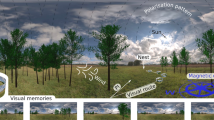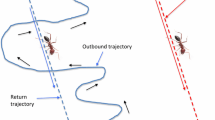Abstract
Using a metric shortcut paradigm, we have found that like honeybees (Dyer in Animal Behaviour 41:239–246, 1991), humans do not seem to build a metric “cognitive map” from path integration. Instead, observers take novel shortcuts based on visual landmarks whenever they are available and reliable (Foo, Warren, Duchon, & Tarr in Journal of Experimental Psychology-Learning Memory and Cognition 31(2):195–215, 2005). In the present experiment we examine whether humans, like ants (Wolf & Wehner in Journal of Experimental Biology 203:857–868, 2000), first use survey-type path knowledge, built up from path integration, and then subsequently shift to reliance on landmarks. In our study participants walked in an immersive virtual environment while head position and orientation were recorded. During training, participants learned two legs of a triangle with feedback: paths from Home to Red and Home to Blue. A configuration of colored posts surrounded the Red location. To test reliance on landmarks, these posts were covertly translated, rotated, or left unchanged during six probe trials. These probe trials were interspersed during the training procedure to measure changes over learning. Dependence on visual landmarks was immediate and sustained during training, and no significant learning effects were observed other than a decrease in hesitation time. Our results suggest that while humans have at least two distinct navigational strategies available to them, unlike ants, a computationally-simpler landmark strategy dominates during novel shortcut navigation.




Similar content being viewed by others
References
Aginsky, V. (2001). How visual landmarks are selected during small-scale navigation. Providence: Brown University.
Appleyard, D. (1969). Why buildings are known: A predictive tool for architects and planners. Environment and Behavior, 1, 131–156.
Appleyard, D. (1970). Styles and methods of structuring a city. Environment and Behavior, 2, 100–117.
Batschelet, E. (1981). Circular statistics in biology. London: Academic Press.
Bennett, A. T. D. (1996). Do animals have cognitive maps? Journal of Experimental Biology, 199(1), 219–224.
Bisch-Knaden, S., & Wehner, R. (2003a). Landmark memories are more robust when acquired at the nest site than en route: Experiments in desert ants. Naturwissenschaften, 90(3), 127–130.
Bisch-Knaden, S., & Wehner, R. (2003b). Local vectors in desert ants: context-dependent landmark learning during outbound and homebound runs. Journal of Comparative Physiology. A. Neuroethology, Sensory, Neural, and Behavioral Physiology, 189(3), 181–187.
Chapuis, N. (1982). Mechanisms of spatial-behavior in a returning task in dogs. Annee Psychologique, 82(1), 75–100.
Chase, W. G. (1983). Spatial representation of taxi drivers. In D. Rogers, & J. A. Sloboda (Eds.), The acquisition of symbolic skill (pp. 391–405). New York: Plenum.
Ciancia, F. (1991). Tolman and Honzik (1930) revisited, or the mazes of psychology. The Psychological Record, 41, 461–472.
Collett, T. S., & Graham, P. (2004). Animal navigation: Path integration, visual landmarks and cognitive maps. Current Biology, 14(12), R475–R477.
Collett, T. S., Collett, M., & Wehner, R. (2001). The guidance of desert ants by extended landmarks. Journal of Experimental Biology, 204(9), 1635–1639.
Dyer, F. C. (1991). Bees acquire route-based memories but not cognitive maps in a familiar landscape. Animal Behaviour, 41, 239–246.
Dyer, F. C., Berry, N. A., & Richard, A. S. (1993). Honey bee spatial memory: use of route-based memories after displacement. Animal Behaviour, 45, 1028–1030.
Eilam, D., Dank, M., & Maurer, R. (2003). Voles scale locomotion to the size of the open-field by adjusting the distance between stops: a possible link to path integration. Behavioural Brain Research, 141(1), 73–81.
Etienne, A. S., Teroni, E., Hurni, C., & Portenier, V. (1990). The effect of a single light cue on homing behavior of the golden-hamster. Animal Behaviour, 39, 17–41.
Etienne, A. S., Boulens, V., Maurer, R., Rowe, T., & Siegrist, C. (2000). A brief view of known landmarks reorientates path integration in hamsters. Naturwissenschaften, 87(11), 494–498.
Etienne, A. S., Maurer, R., Boulens, V., Levy, A., & Rowe, T. (2004). Resetting the path integrator: a basic condition for route-based navigation. Journal Of Experimental Biology, 207(9), 1491–1508.
Foo, P., Warren, W. H., Duchon, A., & Tarr, M. J. (2005). Do humans integrate routes into a cognitive map? Map- versus landmark-based navigation of novel shortcuts. Journal of Experimental Psychology-Learning Memory and Cognition, 31(2), 195–215.
Foo, P., Harrison, M. C., Duchon, A. P., Warren, W. H. J., & Tarr, M. J. (2006). Humans follow perturbed landmarks during continuous path integration unless explicitly told to ignore them (in preparation).
Fujita, N., Loomis, J. M., Klatzky, R. L., & Golledge, R. G. (1990). A minimal representation for dead-reckoning navigation—updating the homing vector. Geographical Analysis, 22(4), 326–335.
Fujita, N., Klatzky, R. L., Loomis, J. M., & Golledge, R. G. (1993). The encoding-error model of pathway completion without vision. Geographical Analysis, 25(4), 295–314.
Gallistel, C. R. (1990). The organization of learning. Cambridge, MA: The MIT Press.
Gillner, S., & Mallot, H. A. (1998). Navigation and acquisition of spatial knowledge in a virtual maze. Journal of Cognitive Neuroscience, 10(4), 445–463.
Gould, J. L. (1986). The locale map of honey bees: Do insects have cognitive maps? Science, 232(4752), 861–863.
Gould J. L., & Gould, C. G. (1982). The insect mind: Physics or metaphysics? In D. R. Griffin (Ed.) Animal mind–human mind (pp. 269–298). Berlin Heidelberg New York: Springer.
Hamilton, D. A., Driscoll, I., & Sutherland, R. J. (2002). Human place learning in a virtual Morris water task: Some important constraints on the flexibility of place navigation. Behavioral Brain Research, 1(2), 159–170.
Kearns, M. J., Warren, W. H., Duchon, A. P., & Tarr, M. J. (2002). Path integration from optic flow and body senses in a homing task. Perception, 31(3), 349–374.
Klatzky, R. L., Loomis, J., Golledge, R., Cicinelli, J. G., Doherty, S., & Pellegrino, J. W. (1990). Acquisition of route and survey knowledge in the absence of vision. Journal of Motor Behavior, 22(1), 19–43.
Landau, B., Spelke, E., & Gleitman, H. (1984). Spatial knowledge in a young blind child. Cognition, 16(3), 225–260.
Lee, T. (1962). “Brennan’s law” of shopping behaviour. Psychological Reports, 11, 662.
Lee, T. (1970). Urban neighborhood as a socio-spatial schema. Ekistics; An Introduction to the Science of Human Settlements, 177, 241–267.
Lehrer, M., & Collett, T. S. (1994). Approaching and departing bees learn different cues to the distance of a landmark. Journal of Comparative Physiology A-Sensory Neural and Behavioral Physiology, 175, 171–177.
Loomis, J. M., Klatzky, R. L., Golledge, R. G., Cicinelli, J. G., Pellegrino, J. W., & Fry, P. A. (1993). Nonvisual navigation by blind and sighted: Assessment of path integration ability. Journal of Experimental Psychology-General, 122(1), 73–91.
Lynch, K. (1960). The image of the city. Cambridge, MA: MIT Press.
Maguire, E. A., Frackowiak, R. S., & Frith, C. D. (1997). Recalling routes around london: Activation of the right hippocampus in taxi drivers. Journal of Neuroscience, 17(18), 7103–7110.
Maier, N. R. F. (1932). A study of orientation in the rat. Journal of Comparative Psychology, 14(3), 387–399.
Menzel, E. W. (1973). Chimpanzee spatial memory organization. Science, 182, 943–945.
Menzel, R., Chittka, L., Eichmuller, S., Peitsch, D., & Knoll, P. (1990). Dominance of celestial cues over landmarks disproves map-like orientation in honey bees. Zeitschrift fur Naturforschung C, 45, 723–726.
Morris, R. G., Garrud, P., Rawlins, J. N., & O'Keefe, J. (1982). Place navigation impaired in rats with hippocampal lesions. Nature, 297(5868), 681–683.
Nadel, L. (1990). Varieties of spatial cognition—psychobiological considerations. Annals of the New York Academy of Sciences, 608, 613–636.
O'Keefe, J., & Nadel, L. (1978). The hippocampus as a cognitive map. Oxford: Oxford University Press.
Péruch, P., Giraudo, M. D., & Garling, T. (1989). Distance cognition by taxi drivers and the general public. Journal of Environmental Psychology, 9(3), 233–239.
Péruch, P., May, M., & Wartenberg, F. (1997). Homing in virtual environments: Effects of field of view and path layout. Perception, 26(3), 301–311.
Riecke, B. E., van Veen, H., & Bülthoff, H. H. (2002). Visual homing is possible without landmarks: A path integration study in virtual reality. Presence-Teleoperators And Virtual Environments, 11(5), 443–473.
Spetch, M. L., Cheng, K., MacDonald, S. E., Linkenhoker, B. A., Kelly, D. M., & Doerkson, S. R. (1997). Use of landmark configuration in pigeons and humans.2. Generality across search tasks. Journal of Comparative Psychology, 111(1), 14–24.
Suppes, P., Krantz, D. M., Luce, R. D., & Tversky, A. (1989). Foundations of measurement: Geometrical, threshold, and probabilistic representations (Vol. 2). San Diego: Academic Press, Inc. Harcourt Brace Jovanovich Publishers.
Tarr, M. J., & Warren, W. H. (2002). Virtual reality in behavioral neuroscience and beyond. Nature Neuroscience, 5(Suppl), 1089–1092.
Teroni, E., Portenier, V., & Etienne, A. S. (1987). Spatial orientation of the golden-hamster in conditions of conflicting location-based and route-based information. Behavioral Ecology And Sociobiology, 20(6), 389–397.
Thinus-Blanc, C. (1987). The cognitive map concept and its consequences. In P. Ellen, & C. Thinus-Blanc, (Eds.), Cognitive processes in animal and man (pp. 1–19). The Hague: Martinus Nijhoff, N.A.T.O A.S.I. series.
Thompson, W. B., Willemsen, P., Gooch, A. A., Creem-Regehr, S. H., Loomis, J. M., & Beall, A. C. (2004). Does the quality of the computer graphics matter when judging distances in virtually immersive environments? Presence: Teleoperators & Virtual Environments, 13(5), 560–571.
Tolman E. C. (1948). Cognitive maps in rats and men. The Psychological Review, 55(4), 189–208.
Trullier O., Wiener S. I., Berthoz A., & Meyer, J. A. (1997). Biologically-based artificial navigation systems: Review and prospects. Progress in Neurobiology, 51, 483–544.
Waller, D., Loomis, J., Golledge, R., & Beall, A. C. (2000). Place learning in humans: The role of distance and direction information. Spatial Cognition and Computation, 2, 333–354.
Wang, R. F., & Spelke, E. S. (2002). Human spatial representation: insights from animals. Trends in Cognitive Sciences, 6(9), 376–382.
Wehner, R., Bleuler, S., Nievergelt, C., & Shah, D. (1990). Bees navigate by using vectors and routes rather than maps. Naturwissenschaften, 77, 479–482.
Whishaw, I. Q., & Brooks, B. L. (1999). Calibrating space: Exploration is important for allothetic and idiothetic navigation. Hippocampus, 9(6), 659–667.
Wolf, H., & Wehner, R. (2000). Pinpointing food sources: Olfactory and anemotactic orientation in desert ants, Cataglyphis fortis. Journal of Experimental Biology, 203, 857–868.
Acknowledgments
This research was supported by the National Science Foundation (LIS IRI 9720327; 0214383). The authors would like to thank Amanda Forte, Nick Beem, and Jonathan Ring for help in collecting data.
Author information
Authors and Affiliations
Corresponding author
Rights and permissions
About this article
Cite this article
Foo, P., Duchon, A., Warren, W.H. et al. Humans do not switch between path knowledge and landmarks when learning a new environment. Psychological Research 71, 240–251 (2007). https://doi.org/10.1007/s00426-006-0080-4
Received:
Accepted:
Published:
Issue Date:
DOI: https://doi.org/10.1007/s00426-006-0080-4




